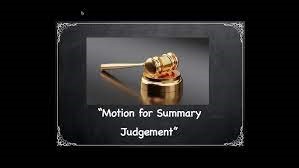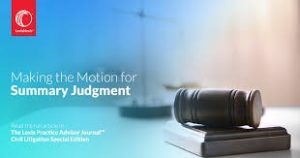
A motion for summary judgment mainly seeks to expedite the litigation process by eliminating the need for a trial. This is by asserting that there is no substantial dispute that needs to be examined by the judge hence the need to issue a ruling based on law. A motion for summary judgment disallows the court from deciding issues of fact. Instead, the court is mandated to examine the proof and pleadings to determine if the trial procedure is indeed merited.
Further, a motion for summary judgment entails a legal motions requesting the court to issue summary judgment on one claim (at least). If the motion happens to be granted, then a decision is made on the said claims without going through the trial procedure. Basically, the motion ought to demonstrate that there is no genuine issue of material fact that exists. Moreover, the opposing party will lose on the claim despite the allegation being accepted as factual. Hence the Plaintiff or movant is entitled to the summary judgment, not as a matter of fact but law. Additionally, a summary judgment can be partial in the sense that the court only grants the resolution of certain elements of a defense or claim.
The Right to File
Unlike popular belief, a motion for summary judgment is a pleading available to the plaintiffs. Plaintiffs are entitled to file, among other pleadings, a motion for summary judgment. This is with the aim of speeding up the legal proceedings by acquiring a judgment without the going to trial. The preceding legal process is common. Nonetheless, the court handling the legal motion must have the requisite jurisdiction and exercise it judiciously.
Purpose and Strategy
The main purpose of filing a motion for summary judgment is to resolve a case expeditiously in favour of the filing party. The litigation strategy also comes in handy in saving on time and expense that comes with going to trial. Furthermore, the said litigation strategy aids in legally compelling the defendant to embracing the possibility of a settlement.
Timelines

Normally, the motion for summary judgment is filed after the discovery process but before trial begins. Nonetheless, the rules of the court are different based on the jurisdiction.
Furthermore, the timeline for deciding a motion for summary judgment varies. Nonetheless, it involves the following steps:
- Under the Federal Court rules, unless there is a different time set by the local rules or a valid court order, the movant may file a motion for summary judgment within 30 days of the discovery process. The movant should also demonstrate that there lacks a genuine dispute over material facts and is legally entitled to a summary judgment.
- The non-movant is allocated time to file the response to the motion for summary judgment and ought to demonstrate that there exists disputed facts that cannot be based on improbable references, speculation and allegations.
- Both the movant and non-movant will be granted the opportunity to present their legal argument before court hence a hearing. A court could either grant the motion or deny it. See what happens when the court deny motion for summary judgement.
Steps for Filing the Motion
All legal cases involve a similar legal process of filing for a motion for summary judgment. The following steps are involved:
- Preparing the motion
- Accumulation of admissible evidence along with relevant affidavits
- Filing the legal documents with the court with the requisite jurisdiction.
The preceding legal procedure often entails legal briefs and a deep comprehension of both the relevant case law and facts.
Under a motion for summary judgment, the party ought to assert facts that are genuinely in dispute in accordance with the record. Further, the non-movant is issued with sufficient notice and reasonable time to file their respond. Afterwards, the court selects whether to grant or deny the motion for summary judgment. The court could also grant the motion for summary judgment for a non-movant or consider the motion on its own. Hence the court has the discretion to either consider the evidence, grant partial judgment, issue summary judgment or deny further discovery.
Legal Pre-requisites
The documents involved in a legal motion can be many. Basically, legal documents, among others, entail a drafted motion, a supporting brief and admissible evidence, and affidavits inclusive. The paperwork that goes into this motion can be extensive. Proper legal documents are significant for the motion to be considered by the court.
Federal vs. State Rules
The process of filing a legal motion depends on whether one’s legal case is categorized under state or federal jurisdiction. While state courts have specialized set of court rules, Federal courts abide by the Federal Rules of Civil Procedure. Under Rule 56 of the Federal Rules of Procedure, a motion for summary judgment may be filed within 30 days of the discovery process. Both court rules have a significant impact on the success of the motion.
Potential Risks
Just like most litigation strategies, a legal motion has risks. The court could, in some instances, deny the motion in the event of disputed facts that necessitate the trial procedure. Moreover, motions that do not succeed could loop in the defendant on insights of the plaintiff’s litigation strategy.
Case Law and Precedents
Having a good grasp of the precedents in relation to a party’s motion for summary judgment could provide a party with significant insights. Case law are viable guides as they assist parties as well as the court to reach informed and favourable decisions.
Legal Aid
Owing to the complex nature of motions of summary judgment, a party ought to seek legal advice of experts. Such consultation could aid in provision of strategy, guide on the discovery proves as well as pleadings. The same could also come in handy in determining a party’s procedural steps in one’s legal case.
Conclusion
Though a motion for summary judgment expedites a legal case, it comes with its risks and complexities. Hence the need for sufficient preparation, a comprehensive understanding of the jurisdictional rules and a well mapped out litigation strategy.
